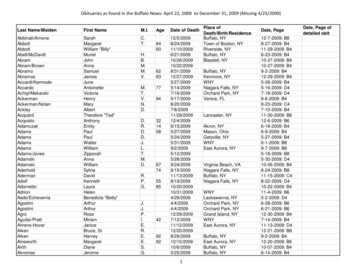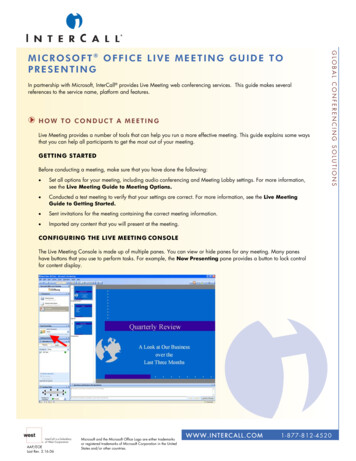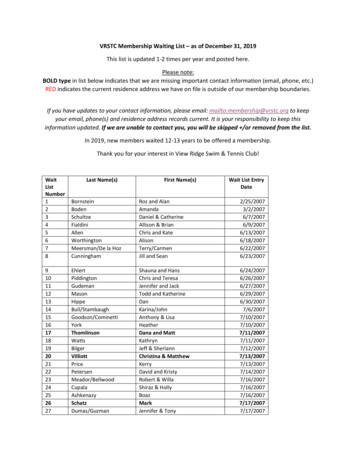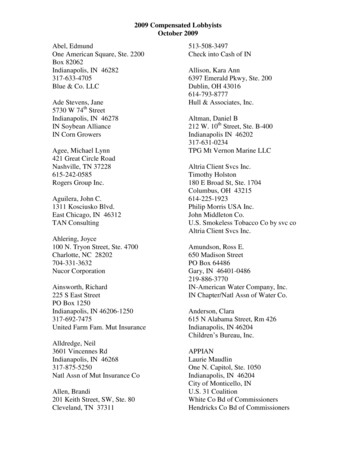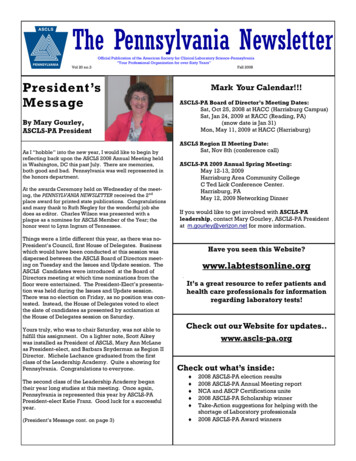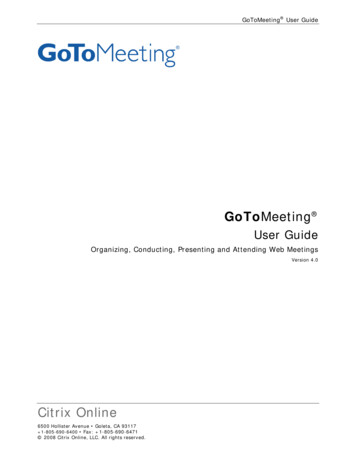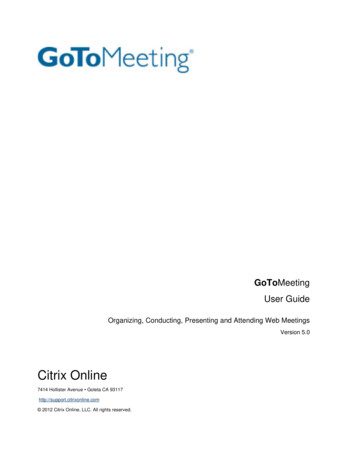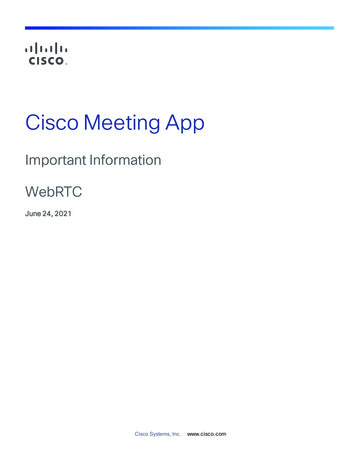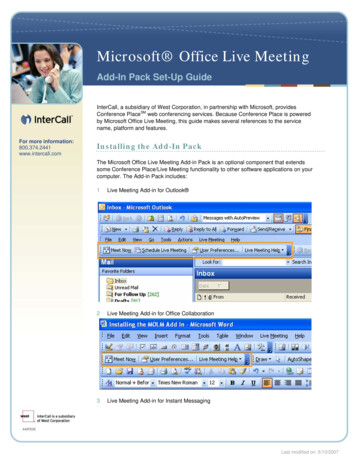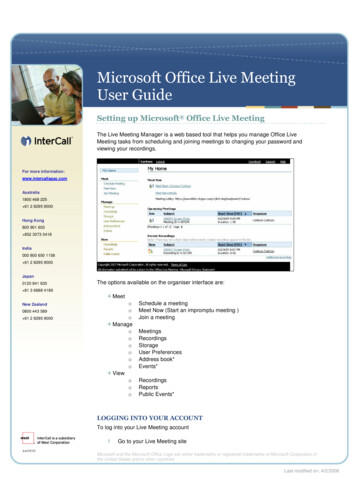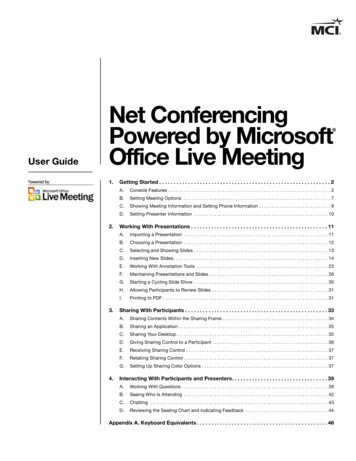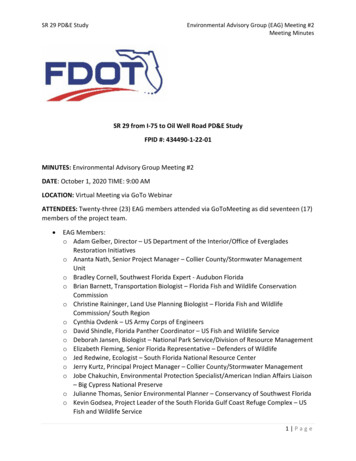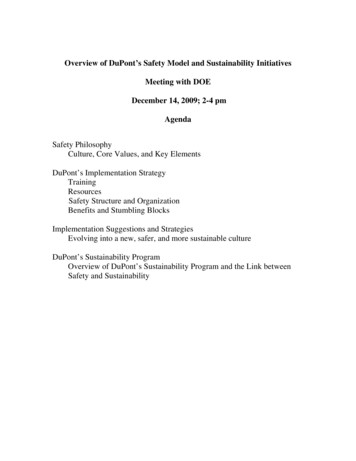
Transcription
Overview of DuPont’s Safety Model and Sustainability InitiativesMeeting with DOEDecember 14, 2009; 2-4 pmAgendaSafety PhilosophyCulture, Core Values, and Key ElementsDuPont’s Implementation StrategyTrainingResourcesSafety Structure and OrganizationBenefits and Stumbling BlocksImplementation Suggestions and StrategiesEvolving into a new, safer, and more sustainable cultureDuPont’s Sustainability ProgramOverview of DuPont’s Sustainability Program and the Link betweenSafety and Sustainability
Topics to Consider- DuPont Safety Model Presentation to DOE Undersecretaries –December 14, 2009DuPont Safety Model DuPont’s safety model serves as a core value, is fully integrated into the company’sculture, is strongly endorsed by leadership and is considered essential to companygrowth. DuPont’s safety groups are well respected within the organization and are organized towork collaboratively with individual plant representatives to solve problems andshepherd company missions.DOE Challenges in Safety Program Execution The implementation and execution of DOE’s safety program must be designed toaddress: Scientific and highly technical operationsOperations governed by intense federal regulationsAnalysis to support executive level decision-makingTransparency to outside regulatorsReduction of areas burdensome to missionQuestions for Consideration What strategy did DuPont follow to initiate and sustain a favorable safety culture,positive program execution and improved safety performance? How can DOE best understand the differences in the way the two programs are executed? What steps can be taken at DOE to address the differences that would enhance DOE’sexecution improvements without increasing burden to DOE’s mission? How did sustainability concepts aid your approach to safety?
Background Information and Resources- DuPont Safety Model Presentation to DOE Undersecretaries Tab Number:1.Topics to ConsiderDuPont (Tabs 2-4)2.Felt Leadership and Safety Culture – Principles of an effective safety culture3.DuPont 2015 Sustainability Goals – Outline and summary of DuPont’s goals for corporate growth,market dominance, and safety performance4.DuPont 2008 Sustainability Progress Report – Summary and progress report towards meetingthe 2015 Sustainability GoalsFord Motor Corp. (Tabs 5-6)5.Ford’s Health and Safety Program within its Corporate Sustainability6.Ford “Blue Print for Sustainability” – Five key material issues comprising Ford’s sustainabilityprogram7.Lockheed Martin Energy Environment Safety and Health Sustainability Report – 2007 progressreport on meeting long-term sustainability program goals, including management approaches tosafety and health8.United Technologies Commitment Improvement Report – Highlight of the five key commitmentareas, including discussion of safety performance indicators9.Pfizer Environment Safety and Health Component of Its Corporate Responsibility Report –Overview of key performance indicators as measure of performance goalsDow Chemical (Tabls 10-13)10. Dow Chemical’s Health and Safety Program within its Corporate Sustainability11. Drive to Zero: Dow Chemical’s Injury Reduction Journey12. The Long View: Health as a Corporate Strategy for Sustainability. Dow Chemical13. 2015 Sustainability Goal Update, Dow Chemical 3rd Quarter 200914. BP Sustainability Review 2008 – Includes reporting of safety indicators from 2004-200815. Dow Jones Sustainability Indexes – An introduction to the DJ Sustainability Indexes, whichmeasures selected companies’ progress in meeting long-term economic, environmental, and socialcriteria16. Global Environmental Management Initiative (GEMI) Clear Advantage: Building Investor Value– The link between ES&H and shareholder value17. Sustainable Enterprise Quarterly – “Thinking about Sustaining Worker Health” – Upwardcommunication of worker safety concernsCIVILIAN RADIOACTIVEWASTE MANAGEMENT18. CSIS Project Horizon Progress Report – Discussion on efforts to develop strategic interagencycapabilities in which to invest, plan, and prepare for future threatsMaterials Compiled by the Office of Health Safety and Security
Background Information and Resources HighlightsDuPont Safety Model Presentation to DOE UndersecretariesDuPont (Tabs 2-4)Tab 2: “Felt Leadership” and Safety Culture DuPont’s “Felt Leadership” program is a critical part of its safety management system,which and is made up of 22 safety elements. “Felt Leadership” is an explicitacknowledgement that safety is a core business value and integral to the very existence ofthe organization. This acknowledgement has a profound effect on employees. Theybecome an active part of building a safety culture. “Felt Leadership” is a public proclamation of an organization’s commitment to caringabout people. It is a proactive approach to building trust and lasting relationships amongemployees, customers, shareholders and communities. Strong, visible management commitment is the basic component of a successful safetymanagement system, and this commitment must start at the top and permeate through alllevels of the organization.Tab 3: DuPont 2015 Sustainability Goals Set of sustainability goals to address safety, environment, energy, and climate issues. DuPont is fully committed to these goals and expects to derive an additional 6 billion ormore by 2015 from sustainability related operations. Marketplace goals focus on developing products that better the environment; reduceenergy consumption; have less impact on climate; reduce energy consumption; and helpprotect the public. Environmental footprint goals focus on reducing green house gasses and waterconsumption; increasing fleet fuel efficiency; minimizing carcinogens; and obtainingindependent verification of its sustainability performance.Tab 4: DuPont 2008 Sustainability Progress ReportEnthusiasm for sustainability inside DuPont has grown because it is now directly tied to thecompany’s growth. It is a central factor in their research and development portfolio and theirmarketing and sales functions.Marketplace Goals Progress Increase R&D Investment – Established baseline investment of 320 million Double Revenues – In 2007 revenues were at 5.8 billion. Target is 8 billion by 2015.1
Introduce 1,000 new products or services to make people safer. In 2007, they introduced127.Environmental Footprint Goals Progress Reduce Greenhouse Gas Emissions – Overall, down 9.5% since 2004. Fuel Efficiency – 22% of Dupont’s current U.S. fleet vehicles is using leadingtechnology. Verification of Environmental Management Goals - 36% of sites are ISO 14000Certified.Ford Motor Co. (Tabs 5-6)Tab 5: Ford’s Health and Safety Program within its Corporate Sustainability Safety program focusing on:- Safe conditions - using internal and external benchmarking to drive health and safetyimprovements;- Safe acts - raising awareness of safety issues and reinforce it consistently withemployees via regular communication at work group meetings and trainings formanagers, supervisors and engineers;- Relationship management - maintaining good relationships with all stakeholders.Tab 6: Ford “Blue Print for Sustainability” Blueprint for Sustainability provides a comprehensive look at the company’s progress onfive key areas over the past year: Climate Change, Mobility, Human Rights, VehicleSafety, and Sustaining the Company. For example, the human rights area addressesengagement with individual supplier facilities and key supplier corporate management;and vehicle safety addresses collaborative research efforts with internal/external partnersall of which contribute to sustaining the company and adapting to change.Tab 7: Lockheed Martin Energy, Environment, Safety and Health Sustainability Report Lockheed Martin’s 2007 report covers ESH’s sustainability efforts as well asenvironmental progress. The report details many of the corporation’s ESHaccomplishments, from improved metrics to the introduction of innovative programs thatenhance their ability to conserve and preserve resources. Italso serves as a baseline from which Lockheed Martin will measure subsequentimprovement in both performance and reporting. On a trajectory toward zero injuries, Lockheed Martin in 2007 moved toward the firstmajor milestone in its Target Zero safety program — reducing injuries by 50 percentagainst the 2003 baseline by the end of 2008. This was accomplished through leadershipcommitment, effective safety improvement tools, and enhanced safety training.Lockheed Martin implemented its Injury Reduction Model in 2007 to drive safetyimprovement. The model involves deeper analysis of incident and safety performancedata to identify root causes of high incident rates.2
Lockheed Martin recognizes that sustainability and performance excellence go hand-inhand. They are focused on operating in a way that builds a solid future withoutnegatively impacting the world around them. Lockheed Martin is committed tointegrating sustainability in all decision-making; individually, as teams, and as acorporation.Tab 8: United Technologies Commitment Improvement Report United Technologies (UT) is a 54.8 billion Fortune 50 and Dow Jones IndustrialAverage conglomerate. It’s businesses include: Carrier, Hamilton Sundstrand, Otis, Pratt& Whitney, Sikorsky and UTC Fire & Security. The report defines the five key commitments that focus UT’s business and future:- Performance- Innovation- Opportunity- Responsibility- Results UTC tracks approximately 15 performance indicators targeting governance, environment,products, customer service, suppliers and employees. Reported status in these areas helpstakeholders understand UTC’s progress and performance against other companies andindustry benchmarks. UTC’s most significant challenges fall within the governance, environment, and peopleareas. Indicators measuring injuries and fatalities are helping the company accomplishneeded improvements in these areas.Tab 9: Pfizer Environment Safety and Health Component of its Corporate ResponsibilityReport This ESH component of Pfizer’s 2009 corporate responsibility report illustrates howthoroughly the drug maker has incorporated ESH into its corporate culture and its visionfor sustaining itself. The report acknowledges that responsible ESH practices are ofincreasing interest of stakeholders and, significantly, to shareholders. The report showsand annotates Pfizer’s 12 key ESH performance indicators and progress towards meetingtheir goals. Pfizer recognizes there is an urgent need to move toward a sustainable global economy.As one of the largest pharmaceutical companies in the world, Pfizer has a unique role toplay in driving this change largely through responsible energy and water use.3
Dow Chemical (Tabs 10-13)Tab 10: Dow Chemical Safety and Security Program – An Element of CorporateSustainability In 1995, the Dow Chemical set important goals to improve its ESH performance and wewere recognized for its achievements. In 2006 it set the bar even higher with the introduction of a more ambitious, nextgeneration set of goals. Dow will focus its efforts on strengthening its relationshipswithin the communities where it operates, continuing to improve its product stewardshipand innovation to solve some of the world’s most pressing problems, and on reducing itsglobal footprint. Dow is relentless in leading the entire industry in security and manufacturing safety. Asa strong advocate, its work in these areas has been and will continue to be thorough andextensive.Tab 11: The Drive to Zero: Dow Chemical’s Injury Reduction Journey This report recounts how Dow has attacked the critical challenge of continuallyimproving its safety performance. Keeping the environment and the people who work atthe company safe is part of Dow’s mission and is fully integrated into its operations. As part of its “Drive to Zero” safety program, Dow set aggressive safety performancegoals from 1996 to 2005; specifically, to reduce by 90%:- Injuries and illnesses- Leaks, breaks and spills- Transportation incidents/10,000 shipments- Fires, explosions, and significant chemical releases, and- Reduce motor vehicle incidents per 1 million miles by 50%Tab 12: The Long View: Health As a Corporate Strategy for Sustainability Dow’s 2005 Executive Summit on Worker HealthPresents features of the three phases of Dow’s worker health effort:Phase 1: 1997 – 2002: Health and Human PerformancePhase 2: 2002 – 2004: Business AnalysisPhase 3: 2004 – Present: Development of a Health Strategy - 5 key elements- Prevention- Quality and Effectiveness- Health Care System Management- Aligned economic Incentives- Advocacy4
Five Take Home Points- Health is a business priority- This is a very complex and challenging area- A simple strategy built on a business analysis of the total economic impact healthprovides focus- Select priorities and move forward step by step- Capturing the value of health may require new thinking and a long viewTab13: Sustainability Goals Update 3Q 2009 Dow’s 2015 Sustainability Goals are aligned to three areas:- Collaboration- Innovation- Understanding its impact on global ecosystems Dow recently joined the Department of Energy’s Save Energy Now LEADER Program, anational initiative to promote greater energy security, lower carbon emissions andincrease economic competitiveness among industrial companies.Tab 14: British Petroleum’s 2008 Sustainability Review How BP is adopting sustainable performance as a corporate imperative. Highlightsinclude:- Reviews of a range of BP’s performance and safety metrics for last 5 years- Corporate governance structures and processes- A detailed discussion of whether BP’s operations are becoming safer- Discussions of global energy supply and demand- How BP is addressing climate change issues- BP’s approach to ensuring a competent workforce- How BP operations benefit local communitiesTab 15: Dow Jones Sustainability Indexes A growing number of investors integrate economic, environmental and social criteria intotheir stock analysis and use Dow Jones Sustainability Indices as a proxy indicator forinnovative and future-oriented management.The health and safety criteria are components of the Labor Practices Indicators, andinclude tracking of safety performance, tracking of work-related fatalities, and tracking ofnear misses or similar crisis events.5
Dow Jones Sustainability Index Criteria and WeightingsTab 16. Global Environmental Management Initiative’s (GEMI) Clear Advantage: BuildingShareholder Value GEMI is an organization of leading companies dedicated to fostering globalenvironmental, health and safety (EHS) excellence through the sharing of tools andinformation to help business achieve EHS excellence. GEMI currently has 28 membercompanies representing more than 20 business sectors. GEMI's latest tool in the series was developed to enable businesses to measure, manageand communicate EHS value to the financial community. The document’s three mainsections provide:- Evidence to support the correlation between EHS performance and financialoutcomes.- Ten important EHS-related value drivers and related case studies from GEMImember companies.- Methodology for EHS and Investor Relations colleagues to apply this new knowledgeand engage with senior executives in order to effectively measure, manage anddisclose the competitive advantage derived from superior EHS performance.6
GEMI’s Sustainability IndicatorsTab 17: Sustainable Enterprise Quarterly – “Thinking about Sustaining Worker Health” –Upward communication of worker safety concerns There are great discrepancies between companies in terms of how they manageemployee health and safety. Further, even within the same company, there arediscrepancies in how safety is treated across work groups and over time during thecourse of projects. In the context of safety, leaders within the organization must value and encourageupward communication about safety in order to ensure organizational success. Onecritical question that leaders need to ask: Is this an organization where leadershippractices create an atmosphere of trust such that a free exchange of informationoccurs, or is this an organization where the upward communication of problems iseither ignored or punished. The notion of upward communication is relevant not only for safety issues, but alsofor other strategic priorities such as innovation and organizational learning. Simplyput, employees often see problems, issues and/or opportunities for innovation that arenever brought to the attention of management due to fear or a perception that theirideas are not welcome.7
Research in high-risk environments suggests that high-quality relationships betweenleaders and employees are associated with increased safety communication, increasedsubordinate safety commitment, and fewer accidents. At the end of the day, to create a strong culture for employee health and safety,employees need to see every day and through multiple ways that safety is valued,rewarded, supported, and encouraged.Tab 18: CSIS Project Horizon Progress Report Coordinated by the Center for Strategic and International Studies, Project Horizonbrought together federal senior executives from global affairs agencies and the NSCto explore ways to improve interagency coordination and collaboration. Usingscenario-based planning, the objectives of Project Horizon are to:- Develop strategic interagency capabilities in which to invest, plan, and prepare forthreats that are likely be faced by the U.S. in the next 20 years.- Provide agencies with scenario-planning toolset that could be used to support bothintra- and inter-agency planning- Serve as a starting point for an institutionalized interagency planning process. Rationale- Conducting integrated strategic planning in today’s federal organizations is aformidable challenge. Different offices within an agency often conduct planningand develop plans for strategic, performance, resource, and policy without aunifying framework.- At the interagency level, these challenges are even more difficult and pressing.- Project Horizon aspires to serve as a means for bridging the chasms of the lack ofcoordination in strategic planning. It represents both a reusable, future-orientedinteragency planning process and it nurtures a community of planners that arehelping better connect the government’s global affairs agencies. The five scenarios, or alternative futures, are a world:1) dominated by Asian mega-corporations,2) of rapid technological progress and American-led globalization,3) of regional political and economic power leading to frictions between threemajor power centers,4) marked by persistent terrorism and nuclear proliferation, and5) of global capitalism that fuels rapid economic growth, market integration, andinnovations.8
Putting science to workSAFETY MANAGEMENT
SAFETY MANAGEMENT CONSULTINGToday, energy companies have many good reasons to embracesafety as a strong core value. The global energy industry hasbecome increasingly competitive in recent years.Public sentiment toward such large and highly visible companiesnow reflects the growing desire for these corporate citizensto become increasingly more socially responsible.However, when safety is quoted by company leadership to bea core value, what does it really mean? Is this core value “felt”by the organization at large? Is this a core value that is sharedby all employees and contractors, and is it exercised with truepassion? Or should such proclamations of safety as a core valuebe viewed with skepticism?Each day around the world, many employees and contractorsare injured while at work. In addition, operations are adverselyaffected when injuries to people also result in lost productionfrom operations and damage to property, nearby communitiesand perhaps even to the environment. More broadly, families,friends and communities can also be affected. Harm to peopleand damage to property, communities and the environment cansignificantly raise the stakes for company managementby negatively affecting company owners and even society at large.At DuPont, we believe that the management systems, processesand culture that protect people can be extended successfullyto the protection of property and operations. Perhaps the time hascome to extend the increasingly popular challenge, “No one getshurt today”, to a broader and ultimately more impacting challengewhich is, “No one gets hurt, no property gets damaged and nooperation gets unnecessarily interrupted today.”
Good Safety Good BusinessOver the years, DuPont has seen how improved safety, includingpreventing injuries, saving lives and enabling a more productiveworkforce and more productive plants, also enhances a company’sbottom line. That’s because when resources are more efficientlyused, employee turnover is reduced and manufacturingplant/company operations run more efficiently with enhancedprofitability. All of these factors demonstrate the key truth thatSafety Excellence means Business Excellence.No company can excel until it makes safety a way of life– and a way of doing business.
The annual cost of injuries and incidents is significant.Some costs are clearly visible. For example, the National SafetyCouncil estimates that in the U.S. the average annual costof injuries exceed US 100 billion. This estimate includes costsassociated with insurance administration, loss of wages,medical treatment, uninsured items, and incident investigationsand reporting. In addition, indirect costs such as lost workerproductivity, overtime, poor quality of goods and services,and damage to customer relations and public image can be2-5 times the direct costs.These costs can be multiplied again when one considersthe cost to repair and replace damaged equipmentand the opportunity cost of foregone production resulting froman unexpected disruption of operations. Often, many of theseindirect costs are treated as hidden costs and as such representa significant burden on the “bottom line” of many organizations.As a global operating company with a global consulting servicesbusiness focusing on Workplace Safety and Operational Excellence,DuPont is well positioned to observe macro-trends that arechanging the business environment. Increasingly, DuPont isseeing that safety and operational excellence are top prioritiesfor growth-oriented companies around the world.In working with clients, DuPont also sees many companiescontinue to struggle with profitability and sustainabilitywhile experiencing avoidable injuries to people and damageto equipment and assets.As our world becomes more connected and competitive,and as societal expectations of employers and contractorscontinue to rise around the world, DuPont expects the trendtoward safety and operational excellence to continue well intothe foreseeable future. This trend will be fueled as more andmore companies realize that in the long term, business excellenceand safety excellence are closely related and not in conflict.
The Foundation for ExcellenceIn DuPont experience, the vast majority of injuries are causedwhen people exhibit unsafe behavior at the workplace.For many managers, the occurrence of unsafe behavior amongworkers can be confounding. In some instances, there isa sense that the injured person “should have known better.”However, these simple views ignore the true complexityof the workplace that is revealed when one gets hurt.To find the root cause, one needs to consider the following: “How many times in the past has the worker beenin a similar situation without being hurt?” “Did the worker fully understand all of the risksand probabilities being faced?” “Were employer expectations for the personal safetyof the employee a top consideration and well knownto the employee?” “What did the supervisor do [or not do] to help ensurethe employee’s safety?”When incidents and injuries occur repeatedly, we know thatcommon sense and the right People Protection Equipment arenot sufficient to protect people, property and operations.While unsafe behaviors can be explicitly demonstrated by individualworkers, another form of unsafe behavior is the absence of visibleleadership – from supervisors and management.
To establish a strong foundation for safety excellence, includingreducing the number of incidents and injuries, a safetymanagement system is essential. DuPont has developedand uses a 22-element safety management system that addressesboth the “hard”, technical aspects of safety management, as wellas the “soft”, people aspects. The “hard” elements relateto the critical aspects of a company’s core technology as well asit’s facilities. These elements are absolutely essential to an effectivesafety management system for a hazardous industry. The “soft”aspects address the critical people-related issues associatedwith leadership for safety performance, organization for criticalsupport and leverage and implementation in a way that drivesworker involvement and continuous improvement. The 22-elementsystem from DuPont is a powerful approach encompassingleadership, organization and operational components that guideorganizations on a journey to zero injuries and incidents.These elements include: Strong, visible management commitment (VMC) Clear, meaningful policies and principles (MPP) Integrated organization structure (IOS) Line management accountability and responsibility (LNA) Challenging goals, objectives and plans (CGP) Supportive SHE personnel (SHSP) High standards of procedures and performance (HSP) Continuous training and development (CTD) Effective two-way communication (ETC) Progressive motivation and awareness (PMA) Behavior and observations and audits (BOA) Thorough investigations and reports (TIR) Personnel changes Contractors safety management Quality assurance Pre-start-up reviews Mechanical integrity Changes in facilities Process information Changes in technology Risk assessment and process hazards analysis Emergency response and preparednessResponsibility is clearly placed in the hands of line management,yet all employees are required to act in a safe way as a conditionof employment. Training, auditing and correcting deficienciesimmediately are intrinsic to the safety culture.There are no acceptable excuses for bad behavior.
Safety as a Core Value:The Entry Point to Sustainable ExcellenceSince the early 1800s, when E. I. du Pont introduced safetymeasures into novel construction techniques in his gunpowdermills such as the daily purging of matches from workers’pockets, DuPont has built an extraordinary reputationas one of the world’s safest companies. Throughout two-centuryhistory of DuPont, it’s core values have remained unchanged –safety, environmental stewardship, ethics and respect for people.The Company today has a single corporate safety philosophy:All incidents are preventable. the Goal is Zero.At DuPont, the company’s safety culture is founded on a coreset of guiding principles: All injuries are preventable.Management is responsible and accountable.All operating exposures can be controlled.Safety is a condition of employment.Employees must be trained to work safely .Management must audit.Deficiencies must be corrected.Off-the-job safety is an important part of the safety affort.Safety is good business.Safety must be integrated as a core businessand personal value.DuPont experience has also shown that safety and protectioncan be a strategic business value that links reduced workplaceinjuries to improved business performance. By leveraging it’sover 200 – year history of safety and operating knowledgeand experience, DuPont now helps other leading-edge companiesand organizations make sustainable improvements in theirinsurance and operating costs, security, productivity, productquality, public image and employee morale.
Safety as an Independent CultureDuPont clients have seen significant drops in workplace safetyincidents as they, with DuPont assistance, move from reactiveapproaches to safety to developing an interdependent safety]culture. In an interdependent safety culture, all employees areresponsible for safety and the safety of all employees is equallyimportant.The goal is to foster in each employee —whether it’san executive, manager, supervisor or worker— the attitude thatdoing one’s job safely is an integral component of doing it well,and that safety is not a task which can be accomplishedwithout helping and being helped by one’s fellow employees.Individual contributions to safety can range from efforts onthe part of a factory worker to come to work alert and well-restedso as to avoid errors in judgment, to work schedule adjustmentsby a supervisor which ensure that workers do not becomedangerously bored or tired on the job, to the redesign of the physicalfacilities and task structures by engineers (with direction fromupper management) in order to help workers remain engaged intheir work. Each of these components is necessary for attainingthe overall goal of creating a safe and efficient workplace.
The following DuPont Curve graphicallyillustrates the changes that occur as a companymoves from reactive to dependentto independent and finally interdependentwithin an organizational tive Safety by naturalinstinct Compliance is the goal Delegatedto safety manager Lack of ndent Managementcommitment Coordinationof employment Fear/discilpine Rules/procedures Supervisior control,emphasis and goals Value all people Training Personal knowledge,commitment& standards Internalization Personal value Care for self Practice, habits Individual recognition Help others conform Others’ keeper Networking contributor Care for others Organizational prideFelt Leadership and SafetyIn any organization, there will be people on the left sideof the curve and on the right. It is quite common to haveindividual
independent verification of its sustainability performance. Tab 4: DuPont 2008 Sustainability Progress Report Enthusiasm for sustainability inside DuPont has grown because it is now directly tied to the company's growth. It is a central factor in their research and development portfolio and their marketing and sales functions.
